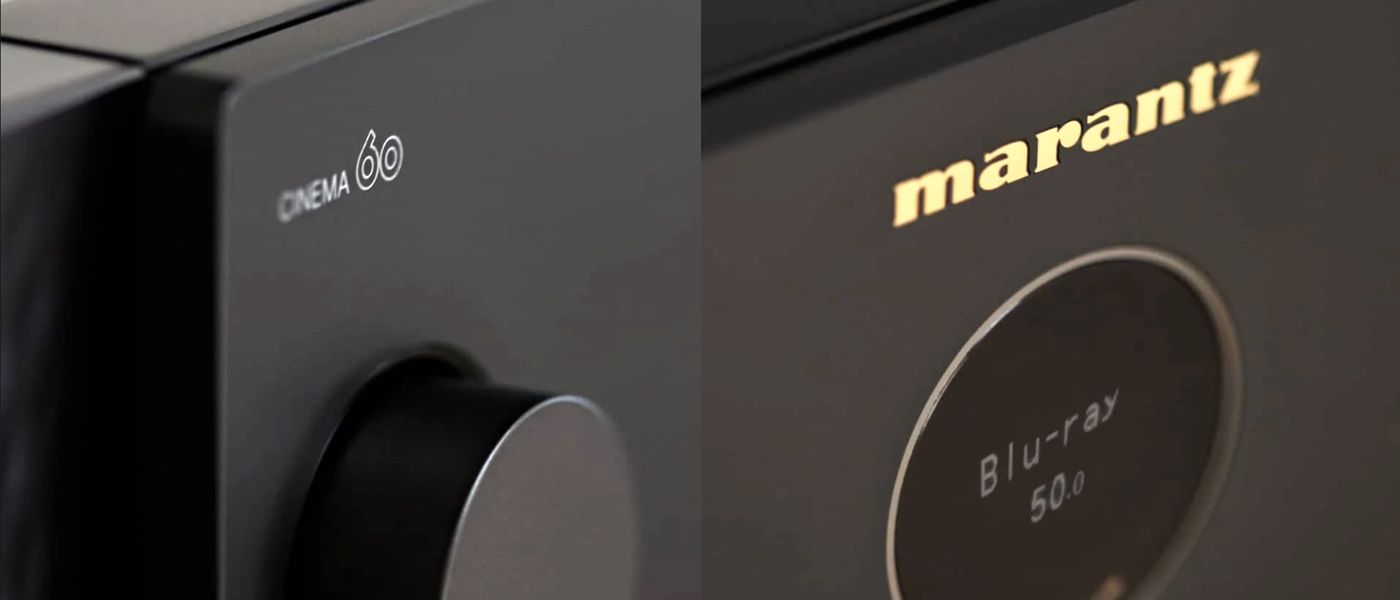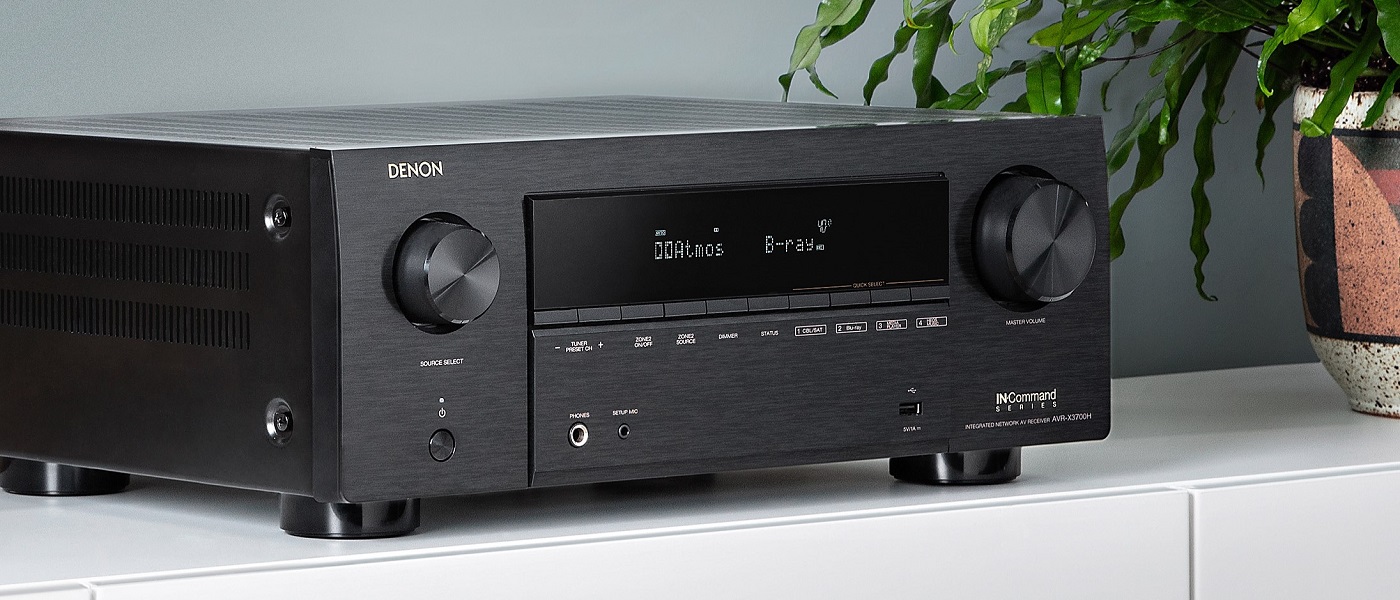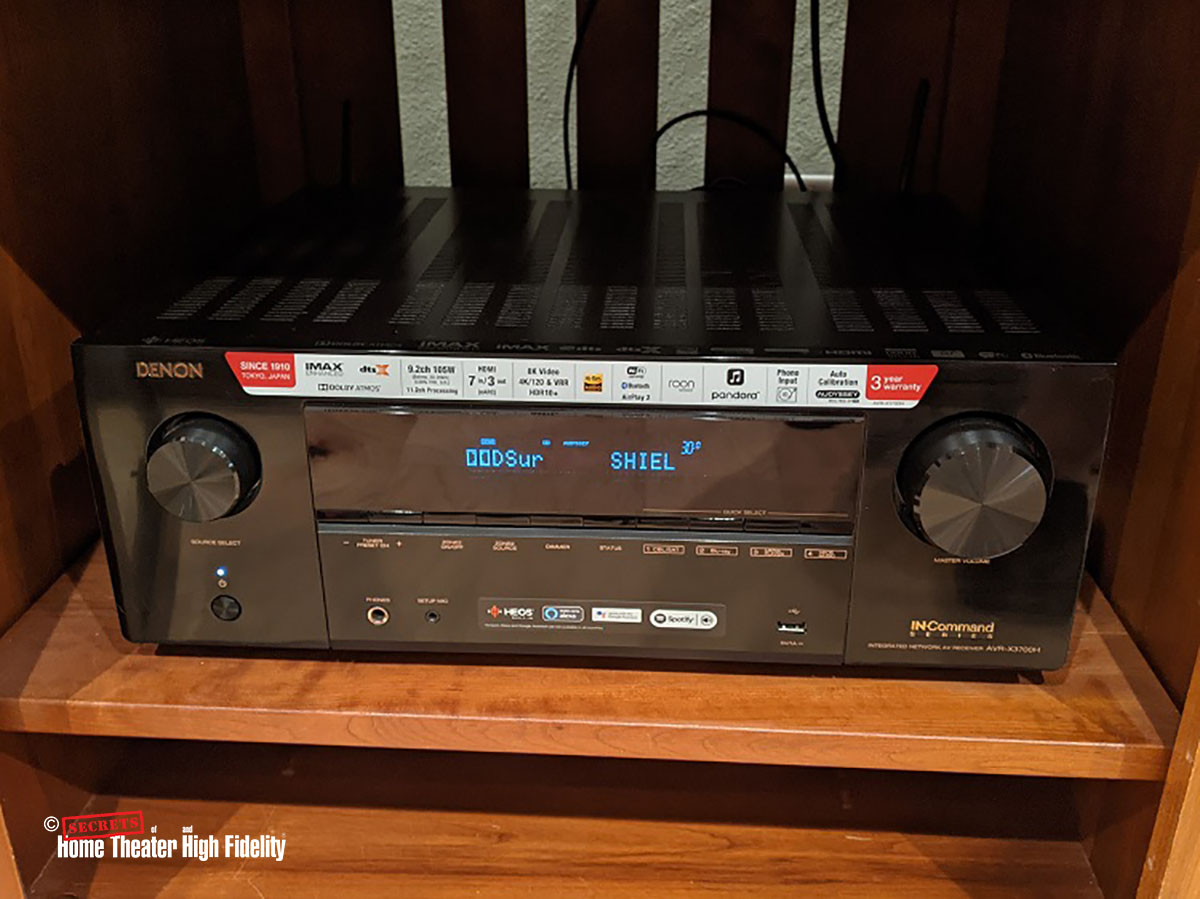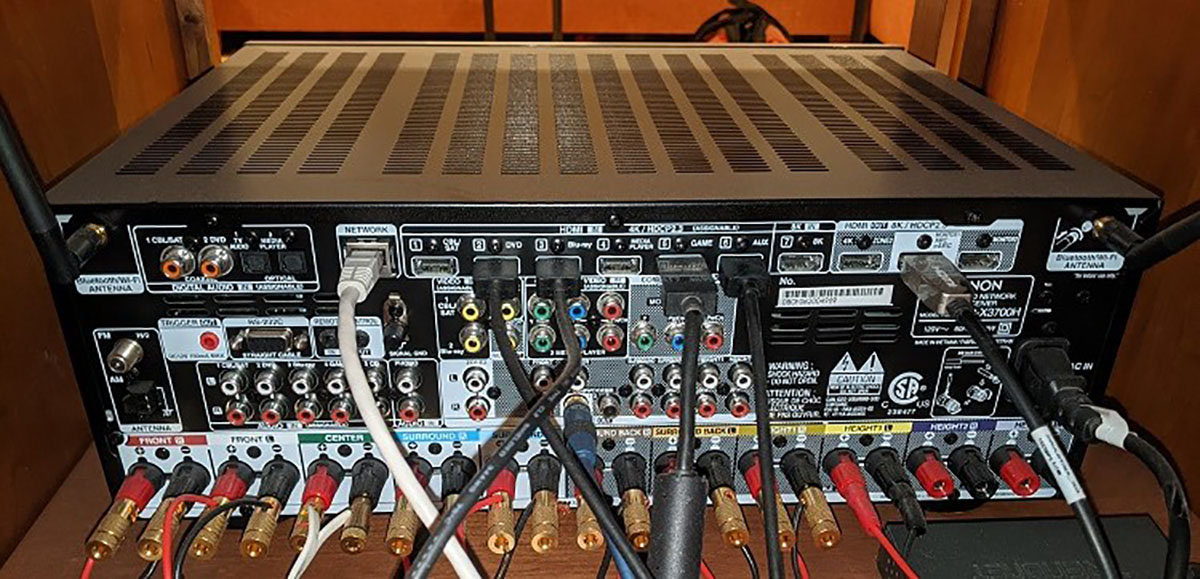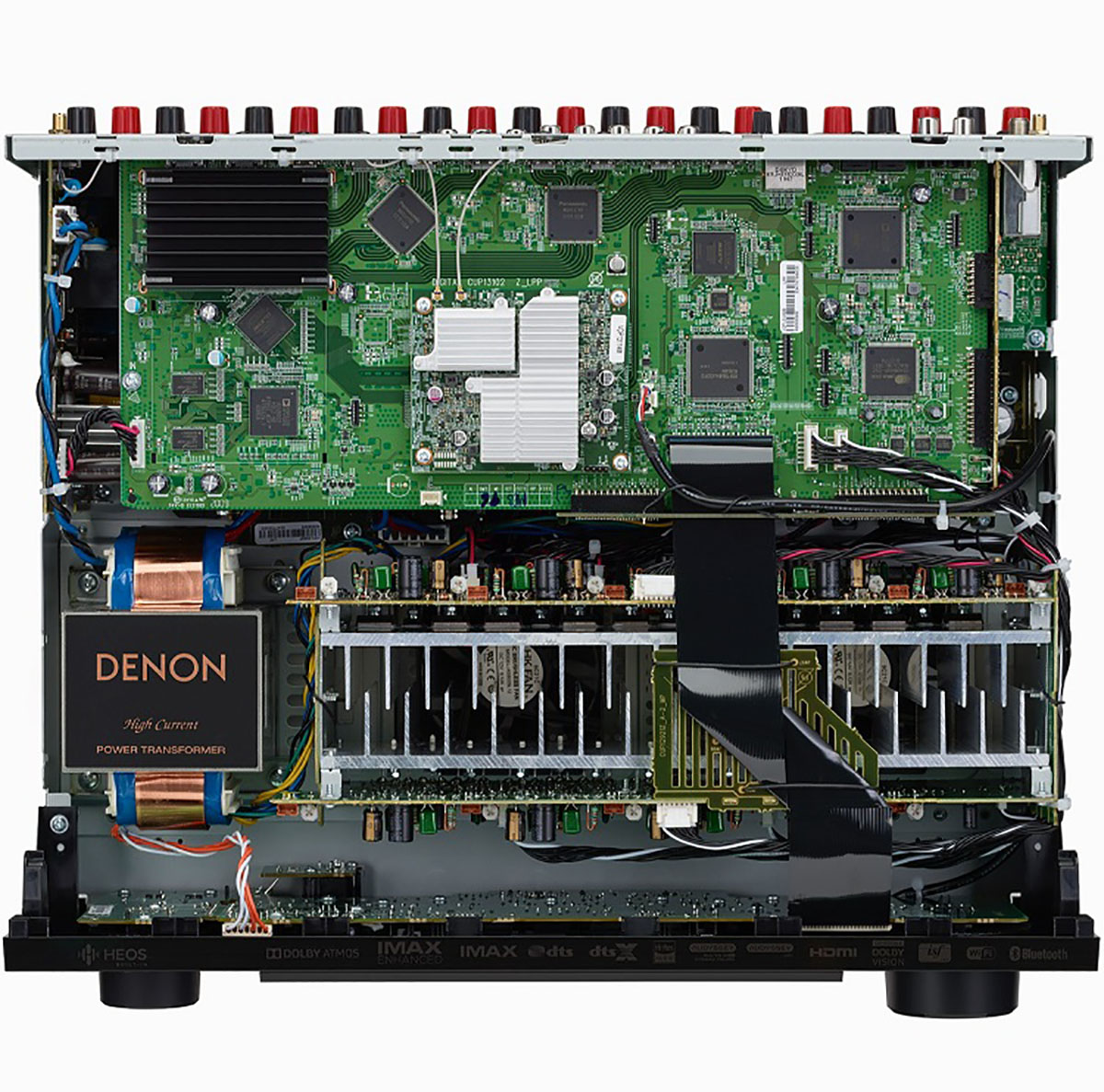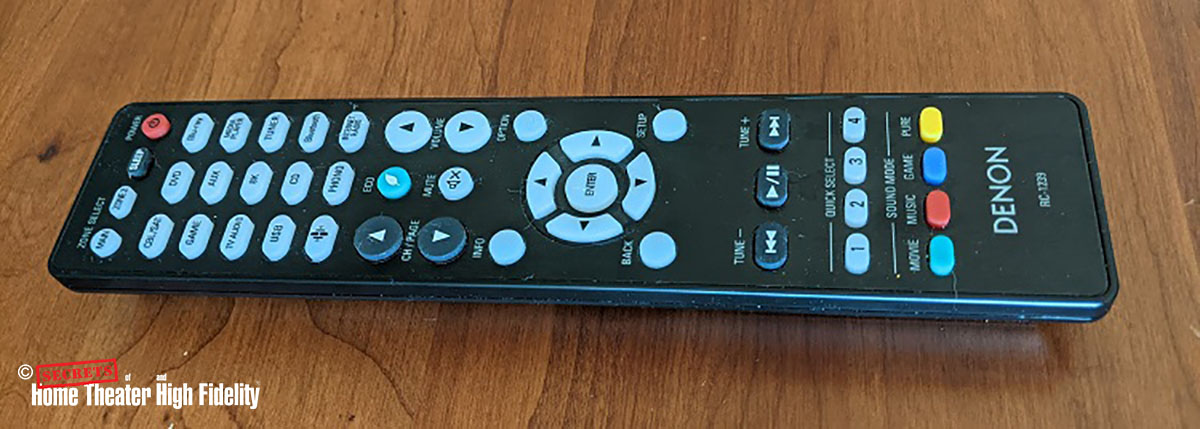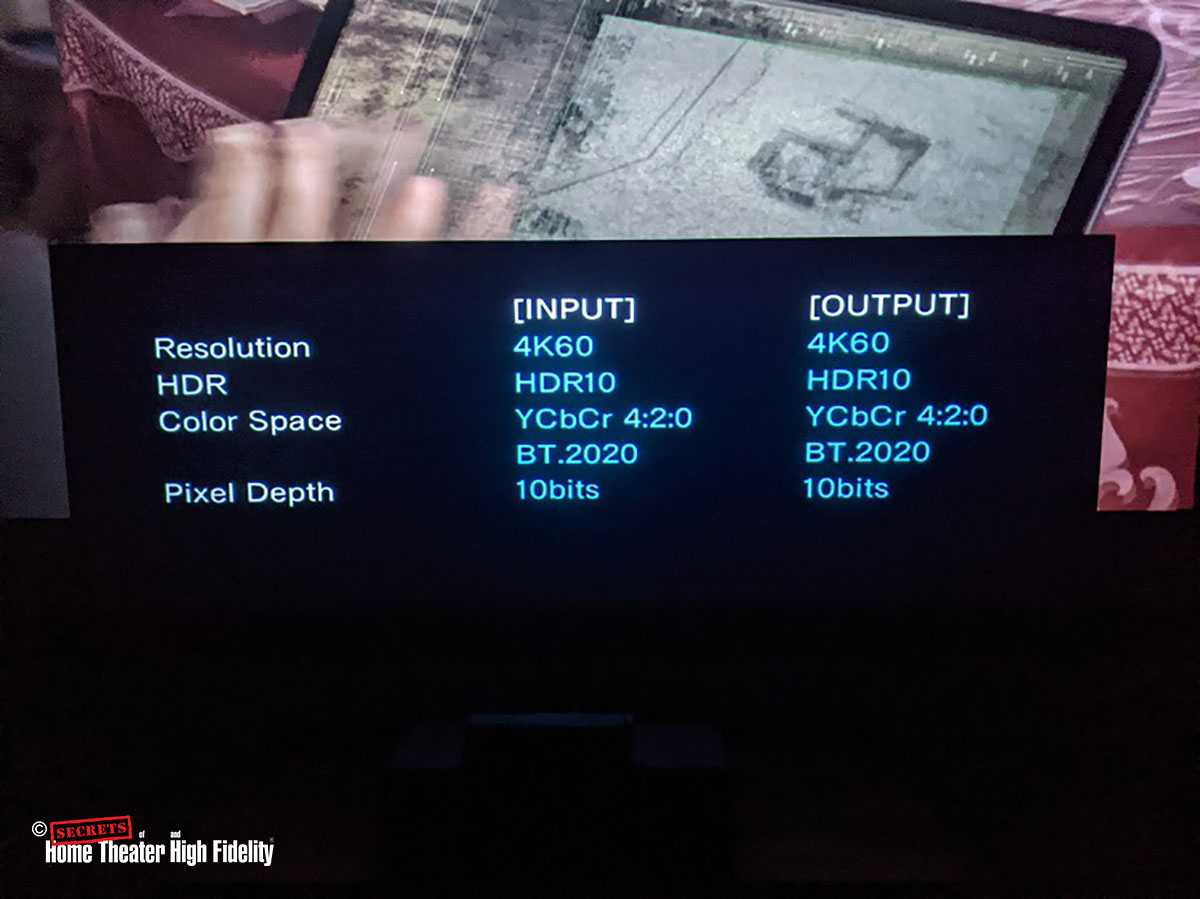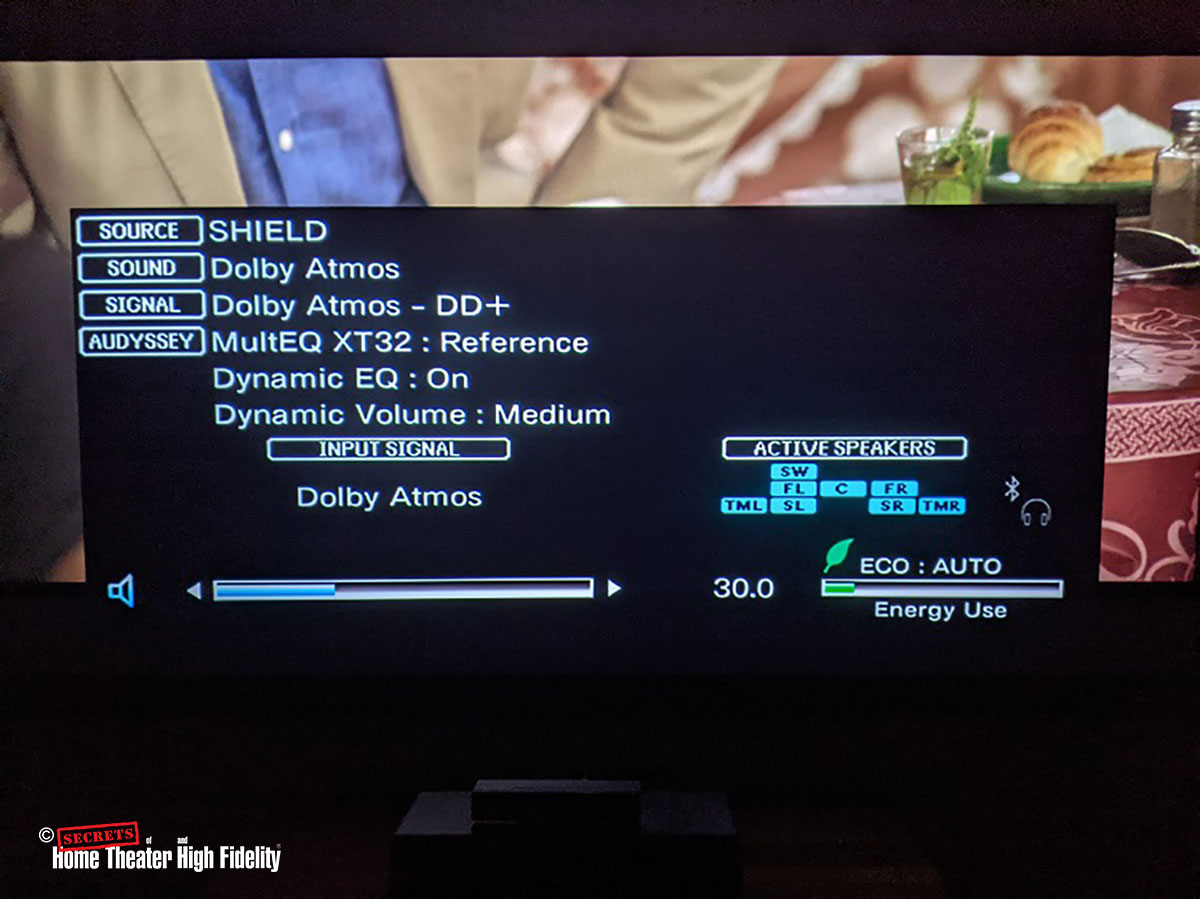I recently purchased the Denon AVR-X3700H to expand and update the video and audio functionality of my home theater, which itself was recently expanded into a new larger room. I now have a 5.1.2 speaker layout, with the potential to add another two speakers in the ceiling or back wall. I also upgraded to a 4K capable projector; so my trusty Yamaha AVR from 2012 was finally going to need replacing. Even though I have been a long time Yamaha AVR customer, the Denon AVR-X3700H checked a lot of boxes for me, most of which are around “bang for the buck” value: it is one of the lowest-priced 9+ channel receivers on the market that also supports HDR and 4K video. The power specs looked sufficient for my needs, and SECRETS had recently reviewed two related AVRs from parent company Sound United. I decided to take the plunge and try owning a Denon AVR for the first time in my HT hobby. Read on to see how that decision played out!
Denon AVR-X3700H AV Receiver
- 9.2 channel mid-price AV Receiver
- 105 Watts per channel
- Dolby Atmos, DTS:X, DTS Virtual:X, IMAX Enhanced (No Auro 3D)
- 7 HDMI inputs, 2 outputs, HDCP 2.3, eARC, 8K/60Hz*, 4K/60Hz with VRR up to 120Hz*
- Audyssey MultEQ XT32 room correction with included microphone and cardboard tripod
It’s been a tough year or two for consumer electronics, and AV receivers have been affected as much as any product; It was a difficult time to go searching for a new AVR. Many stores were simply sold out or back-ordered for most models of most major brands. Faced with needing a new AVR capable of supporting my newly finished family & media room, I turned to the “factory refurbished” market. Recent reviews had me looking at Marantz and Denon AVRs, despite my long-time history with Yamaha AVRs. The mid-range products from Sound United (Denon and Marantz’s parent company) checked all the boxes on features I wanted, while the new Yamaha products were facing delays in coming to market. And, thanks to the reviews here at SECRETS by Chris Eberle and Jim Milton I decided It was time for a change.
The Denon AVR-X3700H is an extremely popular model from Denon, due in large part to its plethora of features, sufficient power, and competitive price point. The question “should I splurge for the AVR X4700H or will the AVR X3700H be enough” is a common question in many online discussion forums. But what does one get with the AVR-X3700H, and is it worth it? At an MSRP of $1499, it’s only $300 less than its big sibling, the AVR-X4700H, and it’s the lowest priced nine-channel AVR from Sound United. That distinction alone is what drew me to this particular product, over many lesser-priced options. If you need nine channels, you need nine channels. But in addition to that, Denon packs in almost every other feature an HT owner or builder could want, including all the major sound formats, two zones, Audyssey MultEQ XT32 room correction, ample connection options, and all the most popular media streaming options, like Spotify, Pandora, TuneIn, Airplay, and digital assistant integration.
CHANNELS:
9.2 channel (dual independent subwoofer outputs), can be configured to 11.2 channel with 2 pre-outs
POWER:
9-channel discrete amplifier, 105W per channel (8-ohm, 20Hz – 20kHz, 0.08% THD 2-channels driven)
MULTICHANNEL AUDIO PROCESSING:
Dolby Atmos, Dolby Atmos Height Virtualization, Dolby TrueHD, Dolby Surround, DTS:X, DTS Virtual:X, DTS HD Master, DTS Neural:X, Multichannel Stereo, IMAX Enhanced
CALIBRATION AND ROOM CORRECTION:
Audyssey MultEQ XT32
HDMI CONNECTIVITY:
7 HDMI inputs (none on the front panel) with full HDCP 2.3 support, 3 HDMI outputs, eARC
VIDEO PROCESSING:
8K/60Hz & 4K/120 Hz full-rate pass-through, 4:4:4 color resolution, HDR10, HLG, BT.2020, and Dolby Vision
ANALOG AUDIO INPUTS:
5 stereo RCA line-level, 1 phono (MM)
DIGITAL AUDIO INPUTS:
2 optical, 2 coaxial, 1 USB
AUDIO LINE-LEVEL OUTPUTS:
11.2 multichannel (2 subwoofer outs), 1 multi-room
VIDEO INPUTS:
3 composite, 2 component
VIDEO OUTPUTS:
1 component, 2 composite
HIGH-RESOLUTION AUDIO FORMAT DECODING:
ALAC, FLAC, and WAV lossless files up to 24-bit/192-kHz, DSD 2.8MHz/5.6MHz
WIRELESS NETWORKING:
Bluetooth and built-in Wi-Fi with 2.4GHz/5GHz dual-band support
STREAMING SUPPORT:
Spotify, Pandora, Tidal, and more (music streaming services may vary by region) via AirPlay 2, HEOS app
HEOS BUILT-IN:
for multi-room audio, voice control, and digital music streaming
VOICE CONTROL COMPATIBILITY:
Amazon Alexa, Google Assistant, Apple Siri, and Josh.AI
DIMENSIONS W x D x H (inches):
17.1 × 14.9 × 6.6 (without antennas)
WEIGHT:
27.6 lbs
MSRP:
$1499 each
Website:
Company:
SECRETS Tags:
Receiver, AV Receiver, Denon AVR-X3700H AV Receiver, Denon AV Receiver, Denon Receiver, AV Receiver Review 2021, Review 2021
I would characterize Denon’s design philosophy for their AVRs as modest. There isn’t much flair to this AVR, and that’s OK by me. It’s a good-looking device, but it doesn’t need to be seen or shown off. The design of the front panel is highly functional with a nicely legible front display, and two large control knobs. There are 10 quick access buttons immediately below the front display, which are nicely non-descript such that you hardly notice them from a sitting distance. Also on the front panel are a phono jack, a calibration mic jack for Audyssey MultEQ XT32 room correction, and a USB port. One of my favorite Denon features is that they tell you very clearly what the surround sound mode currently is; Yamahas, for some reason, always obfuscate this basic information. In addition to the front panel display, there’s an easy-to-find info button on the remote that when pressed, displays on-screen just about everything you’d want to know about the audio and video signals that the AVR-X3700H is currently handling.
Around the back is a rear panel design that has become quite familiar to Sound United customers over the past few years. Both Denon and Marantz receivers color-code their speaker posts and include a sheet of matching color-coded stickers to apply to your speaker wires. When you have 7, 9, or 11 pairs of speaker posts and wires, this is very helpful, especially if you tend to tinker with your setup a lot. Another nice design touch and differentiator from the Yamahas I’m used to is that all the speaker posts are lined up along the bottom of the panel, rather than bunched in a couple of rows to one side. This makes it much easier to keep your speaker wires organized as they exit your AV cabinet.
The amplifier section in the Denon AVR-X3700H is well-sized for a mid-range receiver. With nine amplified channels, it’s rated at 105W per channel at a THD of 0.08%, when two channels are driven. This denotes one of the primary differences between the AVR-X3700H and its pricier sibling, the AVR-X4700H, which offers 20W per channel more, at a lower THD. The X3700H also lacks some higher-end DAC circuitry that the X4700H has on board. I’ve been using the AVR-X3700H with seven speakers so far, each rated at 8 Ohms nominal impedance, and as I’ll talk about in the listening section, I have no complaints.
Another key amplifier feature of the AVR-X3700H is that it is the lowest-priced model to include Denon’s “Pre-Amplifier Mode.” In this mode, the amplifier section is completely disconnected and un-powered, which according to Denon provides a cleaner signal path (makes sense if amps are powered down, there would be less RF noise and cross-talk) and more tolerance in clipping level. This effectively turns the receiver into a pre-amp/processor; the most affordable one with this feature set, I would argue. I did not test out this feature, as I do not have a separates system with an outboard multi-channel amp, but I can’t say that the prospect of upgrading to an external separate amplifier hasn’t crossed my mind ever. With the Denon AVR-X3700H, that’s now more of a possibility.
For video support, the Denon AVR-X3700H has 7 HDMI inputs and 3 HDMI outputs (one of which is tied to zone 2) and supports all the latest signal formats, including eARC, HDCP 2.3, resolution up to 4K/120* and 8k/60*, 3D, and BT.2020 pass-through, and HDR support through HDR10, HDR10+, HLG, and Dolby Vision.
*Early samples of this receiver (built through May 2021) suffered from an HDMI bug that affected the ability to pass 8K/60 and 4K/120 video. This mostly affects Xbox Series X/S owners who need the Variable Refresh Rate feature which requires up to a 4k/120 video mode. To remedy this, Sound United offers free of charge an external HDMI adaptor that fixes the bug; and for receivers built after May 2021 (serial numbers ending with 70001 and higher), the bug has been fixed internally.
The Denon AVR-X3700H is also set up for multi-zone and media streaming support, via a Zone 2 control, and the HEOS app. The limitation of only two zones is one area that differentiates the AVR-X3700H from the AVR-X4700H, and honestly could be the thing that eventually makes me upgrade. This difference is unfortunate since both AVRs have the same number of amplified channels, and the same number of speaker posts, and the same number of maximum channels for processing. So, it seems like support for three zones is just a feature that was reduced for the lower-priced product.
HEOS (Home Entertainment Operating System) is Denon’s proprietary wireless audio streaming service. Like Yamaha’s MusicCast, BlueSound’s BlueOS, and Sonos, HEOS offers easy streaming of many media sources to multiple HEOS compatible devices throughout your home. Using the AVR-3700H’s second amplifier zone and the HEOS system, one can easily cast audio throughout the home, or to just one zone while the other zone plays, for example, a movie. HEOS supports most popular music streaming services, including but probably not limited to, Pandora, Spotify, TuneIn, Deezer, Napster, Amazon Music, Tidal, Rhapsody, iHeartRadio, and Soundcloud. All of these apps are advertised as supported by the AVR-X3700H, but really the support comes from the HEOS app.
Speaking of apps, the AVR-X3700H is also controllable by the Denon 2016 AVR Remote app for smartphones. I found the HEOS app much more user-friendly though. The 2016 AVR Remote app was unreliable and buggy in my experience. When it did work, the functionality was limited. Most of the time if I’m out of the IR range of the AVR, the HEOS app worked fine. If I’m within IR range of the AVR, the remote works fine.
The remote is a standard no-frills remote. It badly needs backlighting and feels a bit on the cheap side when you hold it, but is otherwise decently laid out. I’m getting pretty good at navigating the primary buttons in the dark, but it would really be nice to have a backlight. I wish AVR manufacturers would put more into their remotes. My Nvidia Shield has a sweet little remote that has a motion detector that turns on the backlight, and it’s a combo Bluetooth+IR remote to boot. It’s not perfect, but if a $200 media streamer can include a really nicely designed remote with these basic features, I would think a $1000+ AVR could too. Also, I’m not sure why any device these days is still using IR to transmit remote commands when they all have Bluetooth connectivity.
As a refurbished unit, my AVR-X3700H came in a non-descript brown cardboard box, rather than a retail box in Denon regalia. Inside, the receiver was well packaged and protected, and the critical extras were included: remote, batteries, various antennae (wifi x2, loop AM, FM wire), power cord, and the cardboard calibration mic tripod. Absent was an owner’s manual (I was directed to the online manual) and the color-coded speaker wire labels (this was a disappointment, I must admit!)
Setup was very straightforward: I simply disconnected my previous AVR (Yamaha RX-A2020) and replaced it with the Denon AVR-X3700H, connecting all the appropriate speaker wires and HDMI cables. Thanks to HDMI handshaking, the AVR-X3700H successfully identified all of my components including my display. On to speaker setup, which was a breeze, if a little slow, with the Audyssey MultEQ XT32 system.
The Audyssey system is well known by now, and well documented, with multiple online discussion forums dedicated to setting up various systems with Audyssey’s technology. I had no issues going through the room calibration process, except that it took longer than expected (based on my experience with Yamaha’s YPAO system) and it was unclear where to place the mic when my particular room arrangement did not support mic locations as defined in the on-screen guide. For example, the guide instructs you to place the mic behind the couch a couple of times. My couch is up against a wall. It would be nice if there were optional setup arrangements in the on-screen guide, for a few different but common seating arrangements, rather than assuming just one ideal seating arrangement. I gave it my best shot, and the sound balance and timing seem about right. I did decide to adjust the bass a bit, as well as the overhead speaker gains. I felt that the Dolby Atmos height channel was virtually non-existent in my testing, so I bumped up the channel trims just a tad and felt that made a huge difference. Otherwise, the Audyssey calibration seemed spot-on to my ears.
The initial video setup was likewise easy and straightforward. There are several options to enable different levels of video processing. The HDMI bypass (known as pass-through in other brands) mode is usually my preference, as I find that I usually prefer either my source or my display to do any upconversion or processing. The one drawback to using the HDMI bypass mode is that on-screen GUI overlays are no longer possible when bypass is enabled. This means that when you adjust the volume, you don’t get to see the volume bar on the screen. If your room arrangement is such that you can still see the front panel display of the AVR-X3700H, then you can see the sound mode, source selected, and volume there. You can still hit the Info button on the remote, but in bypass mode, this pauses the source material and switches the display to show only the info screen, rather than overlaying the info screen on the playing source media. If you want to know that your source video is going untouched by Denon’s video processing, then this is the way to go. HDMI bypass is enabled in the “Settings > Video > Output Settings > Video Mode” menu, and disables all other video processing options. Some of the options available to explore if you do not use bypass include, i/p scaler, output resolution, sharpness, progressive mode, and aspect ratio.
The i/p scaler function controls the rest of the available functions. So, if you turn it off, you have the next closest mode to HDMI bypass, as all other processing (including resolution scaling, and progressive/interlaced processing) will be disabled. This is the mode I ended up choosing for the Denon AVR-X3700H.
With most HT setups these days, everything (the source device, the AV receiver, and the display device) can do some version of video processing. It can take a lot of time and patience to figure out which of your devices has the best processing for your setup. This is usually well worth the time and effort as leaving multiple video processors enabled will undoubtedly result in an inferior image. The fact that the Denon AVR-X3700H allows you to completely (as well as nearly) shut off all video processing makes this process easier. For a detailed explanation of how to systematically test your video signal path, I recommend checking out Spears & Munsil’s instructive article on the topic of choosing a color space: http://spearsandmunsil.com/portfolio-item/choosing-a-color-space-3/ While that article is specific to choosing a color space, the same logic and methodology can be applied to plan a systematic method for testing, for example, which image scaler to use.
The Denon AVR-X3700H is an *audio* and *video* receiver, so let’s talk about how movies and music actually look and sound in real-world use. My system consists of seven speakers and a sub in a 5.1.2 system capable of Dolby Atmos and DTS:X 3D object-oriented sound formats. The speakers are all nominally 8 Ohms; Paradigm Titan V3 bookshelf speakers serve main left and right duty, with a matching Paradigm CC170 at the center. Surrounds are a set of eight-inch in-wall and in-ceiling speakers from Home Theater Direct’s HDX series. On the video front, I have the Epson Home Cinema 5050UB 4K LCD projector paired with a 110” Slate ALR screen from Screen Innovations. My primary source for this system has turned out to be our Nvidia Shield 4K Android TV streaming box, but I also have a UHD Sony Blu-Ray player and an FHD Oppo Blu-Ray player.
Again, I really appreciate how clearly the AVR-X3700H communicates what mode it’s in, including what audio codec, and which video resolution or format is being displayed.
This button is easy to find, and I use it frequently just to double-check that a given bit of streaming media is what I think it is.
As with most people these days, I find myself and my family using streaming more than anything else for both music and movie/show consumption. The quality of streaming has risen to a level that for anything but testing and critical listening, it is quite enjoyable, and the convenience factor really puts it over the edge. Having owned, used, and reviewed many streaming devices over the years, I was very impressed with how quickly and easily the HEOS app found, connected to, and started playing music from, my personal home NAS (a Synology DS1515+). Not only was setup nearly non-existent for HEOS, but the speed with which it browsed the media folder hierarchy of my NAS was amazing. Not even Synology’s own music streaming app can hold a candle to the speed with which I was able to navigate and scroll through the NAS music folders using the HEOS app. The HEOS app did miss when it came to displaying album art; a few albums would show the cover art when tracks played, but most would not; contrast this to the Synology app – which while a tad slower on navigation did show album art while browsing titles.
The list of codecs supported by the AVR-X3700H and the HEOS app is extensive, and for my purposes, complete. My music collection is mostly stored as high-bitrate MP3, with some albums saved losslessly in FLAC, and fewer still in MQA. I’ve been listening to countless streams since installing the AVR-X3700H in my system; for testing material, I went back to a few stand-bys: an MQA of Mozart: Violin concerto in D major – Allegro, by Marianne Thorsen / TrondheimSolistene, a FLAC version of the Dire Straits best-of album, Sultans of Swing/The Very Best of Dire Straits, and The Silver Tree by Lisa Gerrard (you know her voice and music from the soundtracks to Gladiator and Whale Rider) in high bitrate MP3.
I like to start out my testing with a revisit to my old standby, Dire Straits’ Sultans of Swing, their 1978 hit single that is the namesake for their best-of album and an excellent demo piece. It contains strong musical bass, delicate highs, and Mark Knopfler’s rich and ever-so-slightly gravelly baritone. The FLAC version I ripped from the original CD did not disappoint; every detail is there from Knopfler’s vocals to the subtle finger drags on his guitar strings. Everything was clean, crisp, and detailed, but warm – not overly harsh. I had an old impression that Denon AVR sound was too warm for my liking with highs too much rolled off and that Yamaha always had the detail and crispness I preferred. Not so now! This Denon is very pleasing to my ear. We are off to a solid start.
Moving on to classical, my positive impressions continued. The Mozart violin concerto was reproduced with wonderful detail and richness. As with the vocals on Sultans, the orchestra and solo violin were rendered with wonderful neutrality by the Denon. The voice of the solo violin was pure, front and center. The orchestra was nicely balanced in the background. I felt that the Denon’s sound was truly neutral which is high praise for any amplifier, especially a solid-state integrated AVR.
Silver Tree, by Lisa Gerrard, is a bit of a mind-bender, as is much of her music. Gerrard’s voice is legendary in its ethereal rasp that grabs you by the guts and won’t let go. Her accompanying music is also other-worldly, and the combo is excellent as background music when I need to focus, be it for getting work done, or ironically, for meditative disconnected time. I typically prefer to do music in straight-up stereo, since that is how most is mastered. However, with Lisa Gerrard and other similar alternative or new-age music, I often prefer a surround decoder in the mix. Both Dolby and DTS have excellent music-centric surround decoders now, and both were very well implemented on the Denon AVR-X3700H. I slightly prefer the more enveloping characteristic of DTS Neural:X Music over the more front-stage bias of Dolby Surround, which is very good as well, just not my preference in this case.
As with music, most of our consumption of movies these days is via streaming. I definitely prefer spinning an FHD or UHD Blu-ray disc when I can, but for sheer convenience and breadth of choice, it’s hard to beat the 1000’s of titles offered across Disney+, Netflix, Amazon Prime, and Vudu, just to name a few of my family’s top apps. Years ago, I happened to write a short blog here at SECRETS arguing that streaming (in 2009, mind you) “HD” was not really “HD” and barely better than 480p DVD at the time. While probably true back then, streaming 4K now is quite acceptable for most movies. Yes, the physical disc still wins, but the difference is getting smaller and smaller. As for the AVR-X3700H’s role in our consumption of movies both on disc and via streaming apps, I have very little to say, which is a good thing. As mentioned earlier, I choose to bypass most video processing in the AVR. I used the Spears & Munsil Ultra HD Benchmark to conduct some simple A/B testing to confirm that HDMI bypass mode indeed did what it claimed. I was able to fairly easily switch the HDMI cable to my projector from the output of the AVR-X3700H to the output of the Sony UBP-X800M2 UHD Blu-ray player. Across multiple test patterns, there was zero visible difference between having the AVR-X3700H in HDMI bypass mode, versus connecting the Sony directly to the projector.
This left the sound handling as the main feature to lay judgment upon, and as with the Denon’s handling of music, it is equally impressive with movies. This is my first system (and first review) that includes the current slate of 3D object-oriented sound (OOS) formats like Dolby Atmos and DTS:X. Admittedly, most of the movies we watched had Dolby Atmos sound. Regardless, the experience is definitely more precise and detailed, especially with surround-heavy action movies.
One question that seems common regarding the AVR-X3700H, is if the amplifier power is sufficient. In this regard, I can say that qualitatively, this amplifier is ample for my purposes. I watched Netflix’s excellent The Old Guard, a fun action thriller that combines aspects of 1986’s Highlander with modern action sequences that have become the standard since The Bourne Identity redefined the genre in 2002. The Old Guard runs 125 minutes, and I watched at just a bit less than reference volume. Not once did I notice any indication that the AVR-X3700H was near its limits, and the space around the receiver was only warm by the end of the film.
At more reasonable volumes, the results were also fantastic. Ever since my colleague Chris Eberle mentioned it in one of his reviews, my wife and I have been working our way through the awesome alternative reality drama series from Apple TV called For All Mankind. Rendered beautifully in 4K HDR with a Dolby Atmos soundtrack, this series is not to be missed. The story starts in 1969 when the Soviets’ landing of the first humans on the moon sets off an alternate reality that takes the viewers through the 1960s, ’70s, and into the 1980s with the Cold War showing no signs of slowing down. Focused primarily on the USA’s space program during that time, there are plenty of spine-tingling sound effects to test the system. But as a drama, we have appreciated the excellent script writing and dialog, combined with popular music of each era scattered throughout each episode. Even at nighttime listening levels, every conversation, whisper, argument, or scream of anguish came through as if the actors were in the room. The Denon AVR-X3700H has been, as it should be, a transparent, unnoticed player in the presentation of the show’s sonic attributes. If a receiver does its job best when it allows the people watching and listening to the media to become fully absorbed in the material; to forget what equipment is sitting in the room with them, to never break them out of that escapism, then the Denon AVR-X3700H has succeeded in spades.
The DENON AVR-X3700H is quite possibly the best value on the market for a full-featured powerful 9.2 channel 8K AV receiver.
- Ample amplification for a mid-range system paired with like speakers
- All the codecs and streaming apps one could want
- HDMI 4KUHD bypass/passthrough
- Value
- A backlight for the remote
- Support for 3 zones
- More and customizable CEC controls
There’s not much more to say. I initially purchased the AVR-X3700H as a stop-gap solution to get 4K, HDR, and 3D surround formats into my new media/HT system, while I waited for the supply chain issues of the past 18 months to work themselves out. However, the performance of this receiver is so good, that I have decided to just hold on to it for the time being. I have no complaints, and in fact, have tons of positive takeaways for the Denon AVR-X3700H.
Setup was a breeze; it has every feature one could want in a modern HT AVR and delivers sound and video quality for which it is nigh impossible to find faults at this price point. Can you get better performance? Sure, but the AVR-X3700H easily sets the bar for the point of diminishing returns, especially if one’s speaker layout doesn’t warrant a higher-end system. When compared to its older sibling the AVR-X4700H, the extra few hundred dollars you would spend over the cost of the AVR-X3700H get you a few key features, including one additional surround sound format (Auro 3D), several higher-quality DACs, one extra zone, and a fair bit more, and possibly cleaner, power (20W per channel additional, with more headroom and lower distortion). So, if you need to drive less efficient speakers or need a receiver that can control speakers in more than 2 zones in your house, then the AVR-X4700H may be worth a listen. But features-wise, the AVR-X3700H is hardly different from the AVR-X4700H and therefore a better value, in my opinion.


